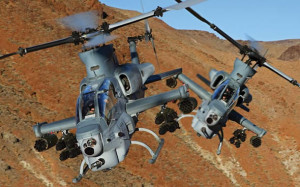

South Korea announced its shortlist of contractors in competition for a multi-billion competition to supply 36 attack helicopters on 29 May. The attack helicopters will be used to strengthen the South’s ability to contend with Pyongyang’s fast gunboats often deployed in the Yellow Sea.
The three finalists are Boeing, Bell Helicopter Textron, and a joint venture AgustaWestland-Turkish Aerospace Industries (TAI) team. AgustaWestland is now a wholly owned subsidiary of Finmeccanica of Italy. Boeing and Bell have a long history of providing helicopters to nations worldwide while AgustaWestland-TAI will deliver the first nine of their new 59 T-129 attack helicopters to the Turkish Army later this year.
To be included on this shortlist is considered a major boost for the credibility of the new AgustaWestland-TAI T-129, a Turkish version of the A-129 Mangusta attack helicopter. The A-129 was the first attack helicopter designed and produced wholly in Western Europe.
Shortlisting the T-129 is significant confidence builder for AgustaWestland-TAI since the aircraft has not yet entered active service and has now been selected to compete against proven performers in the Boeing AH-64D Apache Block III gunship and the Bell AH-1W SuperCobra. The EC-665 Eurocopter was widely considered a strong contender as well, but was not included on Seoul’s shortlist. A Turkish government official has confirmed that South Korean government representatives will be present to observe T-129 testing in July.
Most defense analysts consider the Boeing Apache to be the best attack helicopter available in the world with a distinguished lineage of service history and the Bell SuperCobra is also recognized as a reliable combat aircraft with an impressive heritage. Both American helicopters are expected to come with enticing price tags that are likely to require AgustaWestland-TAI to review and undoubtedly reduce the offering price of the T-129.

South Korean military leaders have previously demonstrated a strong desire to acquire the AH-64D Block III gunship and Boeing is anxious to lock down this multi-billion dollar deal. Bell Helicopter Textron is equally determined to wrap up a deal of this magnitude.The Turkish-Italian team is facing extreme competition from the Americans and this stress, coupled with the fact that Italy is mired in a severe economic crisis, intensifies the pressure on this team to win the order. Some analysts believe that AgustaWestland-TAI will be willing to offer the T-129 at a competitive price in hopes of outbidding the American companies.
Turkey and South Korea have enjoyed friendly political relations since the days of the Korean Conflict and have developed a lucrative level of bilateral trade over the years. Adding further drama to the helicopter competition is the trade imbalance now existing between Seoul and Ankara.
Of the seven billion dollars in trade between the two nations, Turkey’s exports to South Korea account for only about $500 million of the total. This imbalance has created some political headaches for Turkish Prime Minister Recep Tayyip Erdoğan. In light of this situation, when the two nations concluded a free trade agreement recently it included a promise from Seoul that appropriate measures would be undertaken to reduce the imbalance.
Possibly in Turkey’s favor is a soon to be announced selection to name a prime contractor to build a nuclear power plant in the nation’s northern region. South Korea’s Kepco energy giant is in stiff competition with an international array of contenders for this $10 billion contract. Although the power plant deal and the helicopter procurement are not directly tied to each other, selecting the T-129 would go far in balancing the trade imbalance that now exists and might give Kepco a decided edge in the power plant competition.
Also of note is the fact that Turkey builds South Korean field howitzers under a $1 billion licensing agreement. Korean Aerospace Industries is also engaged in a $450 million joint venture with TAI to build 50 basic trainers in the TAI factory, an arrangement that will soon be completed. Another venture, worth $500 million, has South Korea’s Hyundai Rotem assisting Turkey’s Otokar design and produce four prototype tanks. This tank prototype, the Altay, is scheduled for completion in 2017.
India recently decided to reduce the field of competitors to provide 22 attack helicopters to a single contractor, Boeing. The Russian Mi-28N Night Hunter and a version of the UH-1N Huey were recently dropped from the competition leaving the Boeing AH-64D Block III as the last remaining candidate. This development is likely to give the Apache another positive boost in the South Korean competition and in future arm’s deals.
In addition to the attack helicopters, Seoul is also looking at several competing models to fulfill the ROK Navy’s need for multi-mission helicopters that can serve in both anti-submarine warfare (ASW) and anti-surface warfare roles.
On 16 May, the US Defense Security Cooperation Agency (DSCA) formally notified Congress of a potential sale of eight Sikorsky MH-60R Seahawk multi-mission helicopters to Seoul, a deal valued at approximately $1.0 billion that would be executed through the Foreign Military Sales (FMS) program. This notification is required under US law and does not constitute a completed sale.
Seoul is expected to announce a contract winner in October when a winner of the South’s new fighter contract is also announced. The entire South Korean aviation procurement package is estimated to exceed $8 billion.




















